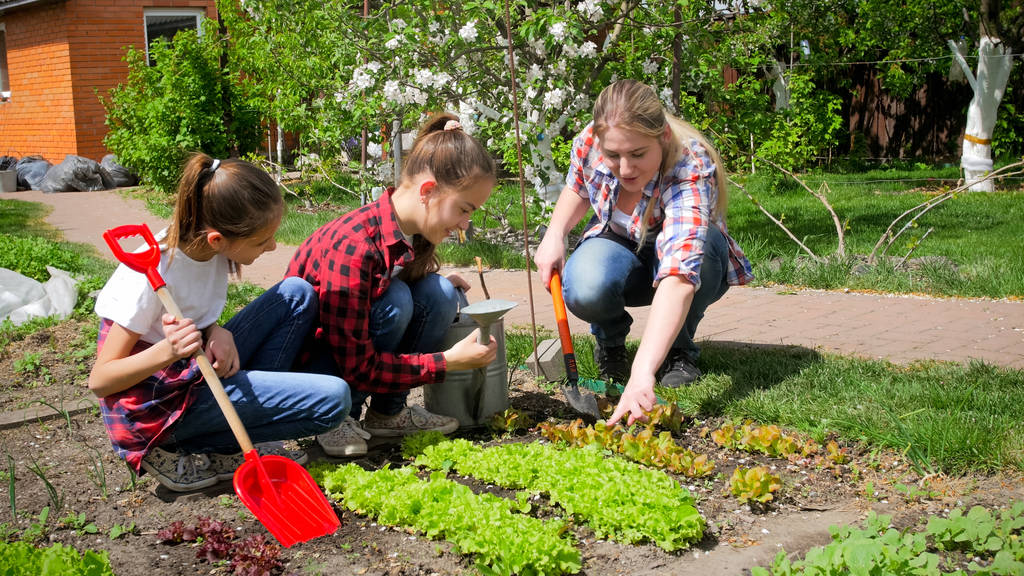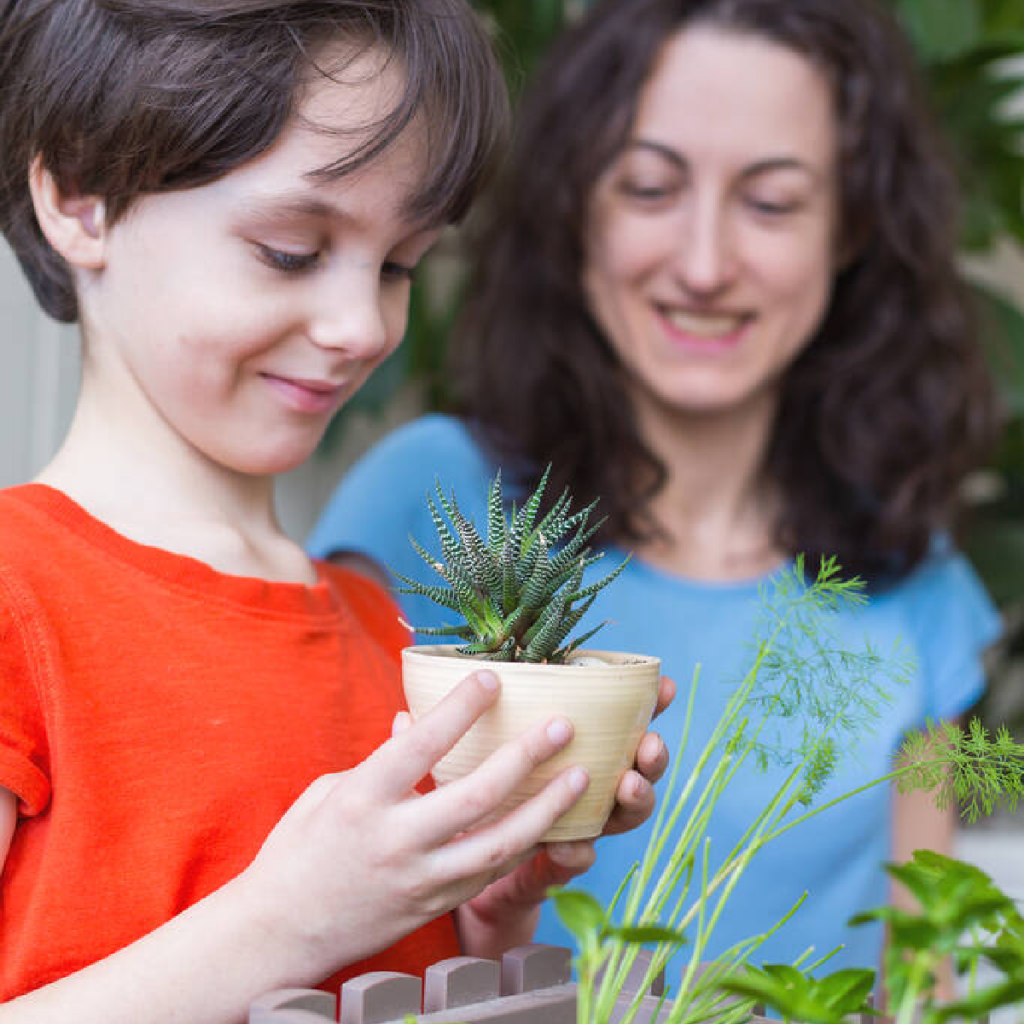Discover how to effectively teach gardening to 7-8 year old children with this comprehensive step-by-step guide.
Teaching Gardening to 7-8 Year Old Children: A Step-by-Step Guide
Teaching gardening to 7-8 year old children can be a delightful and educational experience. Not only does it introduce them to the wonders of nature, but it also helps develop important life skills. In this step-by-step guide, we will explore the importance of gardening for children, how to prepare for your first gardening lesson, introduce basic gardening concepts, and discover hands-on activities to keep them engaged. Let’s dig in!

Understanding the Importance of Gardening for Children
Gardening is more than just planting seeds and watching them grow. It is a powerful tool that nurtures young minds in many ways. Let’s explore some of the benefits:
Gardening teaches children patience, responsibility, and empathy. As they care for plants and witness the growth process, they learn to appreciate the value of hard work and perseverance. It also gives them a sense of accomplishment and boosts their self-esteem.
Moreover, gardening exposes children to various sensory experiences. They get to touch different textures, feel the warmth of the sun, taste the fruits of their labor, and breathe in the fresh scents of nature. These sensory experiences stimulate their senses and promote cognitive development.
But the benefits of gardening for children go beyond personal growth. Let’s delve deeper into how gardening cultivates a love for nature and instills environmental consciousness.
Cultivating a Love for Nature in Children
Gardening is an excellent way to foster a deep connection with nature. Children become more aware of the environment and its importance. They learn about the interdependence of living things and develop a greater sense of responsibility towards the planet.
By seeing the beauty and diversity of plants, children develop a love for nature that goes beyond the garden. It encourages them to explore the outdoors, appreciate wildlife, and become environmentally conscious individuals.
When children engage in gardening, they become active participants in the natural world. They observe the intricate relationships between plants, insects, and animals, gaining a firsthand understanding of the delicate balance that sustains our ecosystems.
Furthermore, gardening provides opportunities for children to learn about sustainable practices. They can discover the importance of conserving water, using organic fertilizers, and avoiding harmful pesticides. These lessons empower children to make environmentally friendly choices and contribute to a greener future.
Through gardening, children also develop a sense of stewardship. They take pride in nurturing their plants and take responsibility for their well-being. This sense of ownership translates into a broader sense of responsibility for the environment as a whole.
Additionally, gardening can be a gateway to learning about food production and nutrition. Children can grow their own vegetables and herbs, gaining an understanding of where their food comes from and the importance of a healthy diet.
In conclusion, gardening is not just a hobby or a pastime for children. It is a transformative experience that nurtures their minds, instills a love for nature, and fosters environmental consciousness. By engaging in gardening, children develop important life skills, cultivate empathy, and become stewards of the planet. So, let’s encourage our children to dig in the dirt, plant seeds, and watch their love for nature and the environment grow.
Preparing for Your First Gardening Lesson
Before you embark on your gardening adventure with the little ones, it is wise to get prepared. Here are a few essential steps:
Gardening is not only a fun and educational activity for children but also a great way to instill a love for nature and the environment. By following these steps, you can ensure that your first gardening lesson is a success!
Gathering Essential Gardening Tools
Make sure you have the necessary tools for your gardening lesson. Child-sized gloves, small shovels, watering cans, and child-safe pruning shears are some of the basics you will need. These tools are not only functional but also designed with the safety of children in mind. Having their own set of tools will make the experience extra special for the little ones, giving them a sense of ownership and responsibility.
Additionally, you can consider providing magnifying glasses and small buckets for collecting bugs and other interesting creatures that children may come across during their gardening exploration. This will not only spark their curiosity but also encourage them to learn more about the ecosystem and the role of insects in the garden.
Setting Up a Safe and Kid-Friendly Gardening Space
Create a designated gardening space that is safe for children. Remove any sharp objects, such as rocks or broken glass, from the area to prevent accidents. It is also important to ensure there is access to water for irrigation. Setting up a child-friendly watering station with a small hose or watering cans will allow the children to actively participate in watering their plants and understanding the importance of hydration for plant growth.
Furthermore, providing ample shade in the gardening space is crucial, especially during hot summer days. You can set up a small canopy or use large umbrellas to create a shaded area where the children can take breaks from the sun. This will not only protect them from harmful UV rays but also provide a comfortable space for them to rest, observe their plants, and engage in discussions about the growth and development of their garden.
Engaging the children in setting up the gardening space will make them feel involved and excited about the project. Let them choose the location, arrange the tools, and decorate the area with colorful flags or wind chimes. This will create a sense of ownership and pride, making the garden their own little paradise.
By taking these steps to prepare for your first gardening lesson, you are setting the stage for a memorable and enjoyable experience for both you and the children. So, roll up your sleeves, put on your gardening hats, and get ready to embark on a green adventure!
Introducing Basic Gardening Concepts to Children
Now that you are all set up, let’s dive into some basic gardening concepts you can introduce to the children:
Explaining the Plant Life Cycle
Start by explaining the fascinating life cycle of plants. Teach them about seeds, germination, growth, and reproduction. Use visual aids like charts or pictures to make it more engaging. Encourage them to observe the different stages of plant development.
When discussing seeds, explain how they contain all the necessary information for a plant to grow. Talk about the different types of seeds, such as those that are dispersed by wind, water, or animals. Show them examples of various seeds, from tiny ones like those of a dandelion to larger ones like acorns.
Next, move on to germination, where the seed begins to sprout and grow. Explain that germination requires the right conditions, including moisture, warmth, and oxygen. Show them how a seedling emerges from the soil, with its tiny roots and leaves.
As you discuss growth, emphasize the importance of nutrients and proper care. Talk about how plants obtain nutrients from the soil through their roots and how they use sunlight to convert those nutrients into energy through photosynthesis. Show them how plants grow taller and develop more leaves as they receive the necessary resources.
Lastly, touch on reproduction, explaining how plants produce flowers and fruits. Discuss the role of pollination, either through wind, insects, or other animals. Show them the different parts of a flower and explain how pollen travels from the male to the female parts, leading to the formation of seeds.
Discussing the Role of Sunlight, Water, and Soil
Help the children understand the importance of sunlight, water, and soil in plant growth. Explain how plants use sunlight to make food through photosynthesis, the role of water in nutrient absorption, and how soil provides essential support and nutrients. Make it hands-on by letting them touch and examine soil, water plants, and create a mini sunlight experiment.
When discussing sunlight, explain that it is the primary source of energy for plants. Show them how leaves contain chlorophyll, a pigment that captures sunlight and converts it into energy. Discuss the different light requirements of plants, such as full sun, partial shade, or full shade, and how it affects their growth.
Move on to water and its role in plant growth. Explain that water is essential for transporting nutrients from the soil to different parts of the plant. Show them how plants wilt when they don’t receive enough water and how they recover when watered. Let them touch and feel the moisture in the soil and explain how roots absorb water from the ground.
Lastly, discuss the importance of soil in providing support and nutrients to plants. Explain that soil is made up of minerals, organic matter, air, and water. Show them different types of soil, such as sandy, clayey, or loamy, and explain how each type affects plant growth. Let them examine soil samples and discuss the different organisms that live in the soil, such as earthworms and beneficial bacteria.
To make the learning experience more interactive, create a mini sunlight experiment. Provide a few plants and place them in different light conditions, such as near a window, in a shaded area, or under artificial light. Let the children observe and compare the growth of these plants over time, discussing the importance of light in their development.
Hands-On Gardening Activities for Kids
Now comes the fun part – getting their little hands dirty! Here are a couple of hands-on gardening activities you can enjoy together:
Planting Seeds: A Beginner’s Activity
Start with a simple activity like planting seeds. Let the children choose their favorite flowers or herbs. Demonstrate how to prepare the soil, make a hole for the seed, and cover it gently. Encourage them to take turns and participate in every step. Remind them to water their plants regularly and watch them grow!
Watering and Weeding: Teaching Responsibility
Teach the children the importance of regular care by assigning them watering and weeding responsibilities. Create a schedule and let them take turns watering the plants and removing any weeds. This helps develop a sense of responsibility and ownership.
Making Gardening Fun and Engaging
To keep the children excited about gardening, incorporate fun elements into your lessons:

Incorporating Games and Challenges into Gardening
Create games and challenges to make gardening a playful experience. Set a time limit for planting or watering, create a scavenger hunt for specific plant parts, or have a friendly digging competition. These activities make gardening more enjoyable and encourage healthy competition among the children.
Celebrating Growth: Acknowledging Children’s Gardening Achievements
Lastly, celebrate the children’s gardening achievements. Organize a mini garden show where each child presents their plants and explains their growth journey. Award them with certificates or small tokens of appreciation. This boosts their confidence and motivates them to continue their gardening endeavors.
Teaching gardening to 7-8 year old children is not only educational but also a lot of fun. By understanding the importance of gardening, preparing for lessons, introducing basic concepts, and incorporating engaging activities, you can nurture their love for nature and cultivate their green thumbs. So grab your gardening tools and embark on this wonderful journey with the little gardeners!



